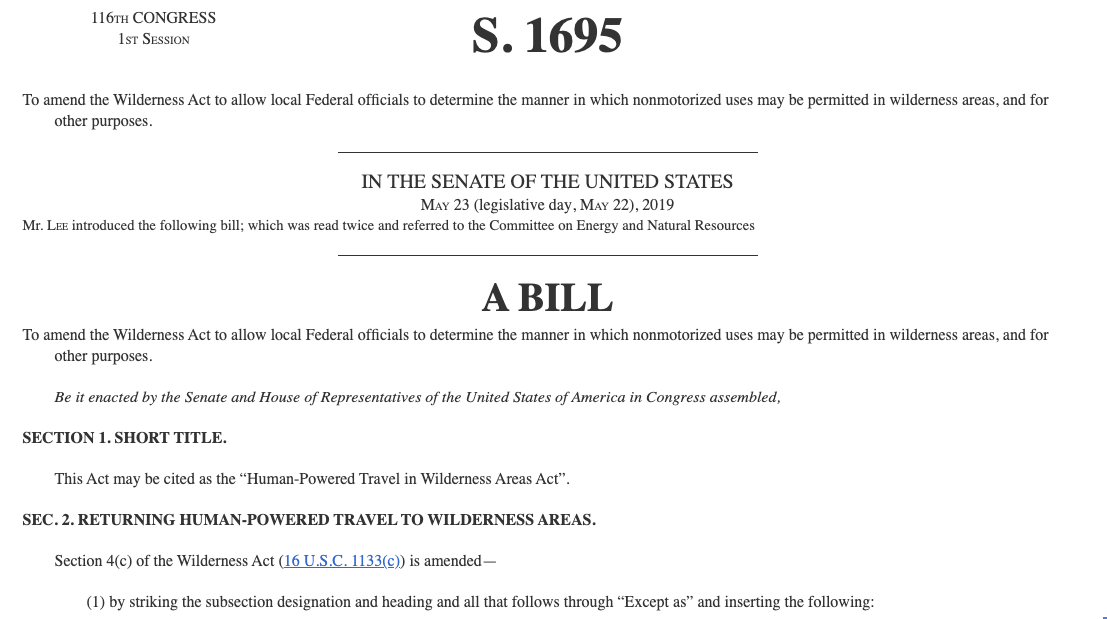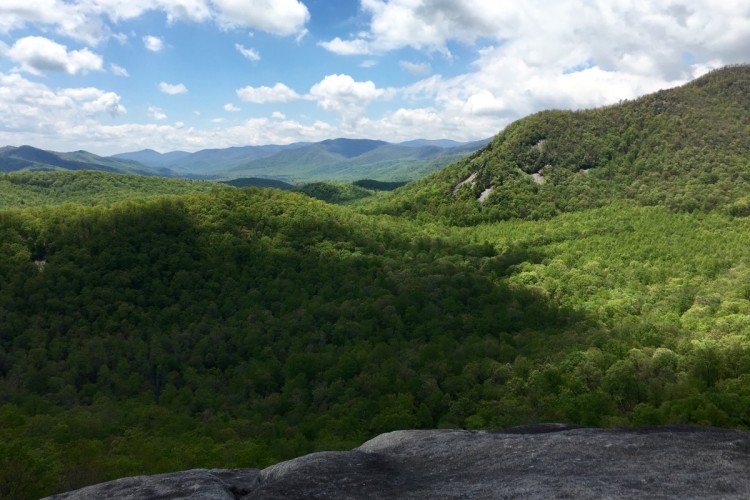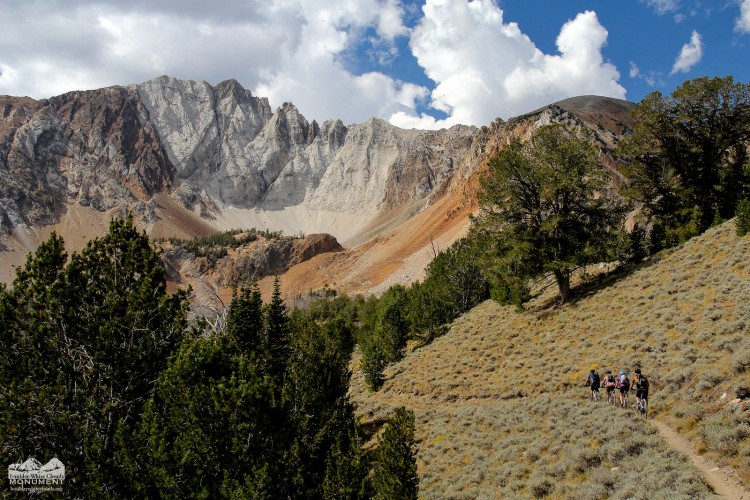
John Fisch is a contributor to Singletracks.com and is a member of the board of directors of the Sustainable Trails Coalition, a non-profit organization dedicated to backcountry access for mountain biking, including consideration of Wilderness trails as legal mountain biking routes. His statements and opinions do not necessarily represent the opinion of Singletracks.
The Senate recently heard testimony from the two federal departments that oversee the bulk of our federally-designated Wilderness areas. Representatives of the US Department of Agriculture, which includes the United States Forest Service (USFS), and reps from the Department of Interior, which includes the Bureau of Land Management (BLM), both testified in favor of S. 1695, The Human Powered Travel in Wilderness Act, which would remove the blanket ban against cycling use in Wilderness areas, giving local land managers the authority to allow bikes on a case-by-case basis.
Chris French, Deputy Chief of the USDA Forest Service, testified:
“The USDA supports increased access to the national forest system lands and thus supports the bill’s intent.”
Michael Nedd, Deputy Director for Operations for the Bureau of Land Management, echoed Mr. French’s comments:
“The [Trump] administration has placed a high priority on increasing public use and enjoyment of all federal lands. S.1695 aligns with this priority by providing greater access and recreational opportunities on public lands and the department supports the bill.”
This testimony is a monumental step toward righting a decades-old wrong: a decision that was made to ban bikes without either legislative review or public input. Rather than rehash all the reasons this is a good thing in terms of scientific evidence, original intent of the Wilderness Act, or just plain equity and fairness, this piece will focus on two things; addressing the sometimes very real (but often created or inflamed by blatant fear-mongering) fears some have regarding this legislation, and demonstrating the actual benefits of the legislation beyond just mountain biking.
What the bill actually says

The most common fear expressed with regard to allowing mountain bikes in Wilderness is that it is just the first step in an erosion of the environmental protections afforded by Wilderness status. Fear-mongerers love to say that today it’s mountain bikes, then it will be motorcycles, then Jeeps, bulldozers, airstrips, mineral extraction, etc. Whether presented as a disingenuous tactic or a genuine concern, these fears are easily laid to rest by three basic facts.
First, the Wilderness Act was in force for two decades before the current bike ban was put into place. During those two decades when bikes were allowed, none of the ills mentioned came to pass.
Second, the proposed legislation is quite explicit that nothing with an artificial powered source is allowed; the words “human powered” are right there in the title of the bill itself, and there is no exception or caveat. Even e-bikes would remain prohibited.
Third, we need only look at the other federal designations that have successfully protected our wild places. We are told that we must have Wilderness because it is the “gold standard” for resource protection. That means that other designations like National Scenic Trail would receive less protection. Yet National Scenic Trails remain well preserved. If the Wilderness designation is even better, surely those places will also remain safe from development.
Another commonly expressed fear is that trails will become overrun with cyclists. This usually boils down to nothing more than another user group not wanting to give up their privileged status and share the trails with another user group. But even for those who may have honest concerns, the first thing to consider with regard to this fear is that this legislation does not by itself open a single trail to mountain biking. It only gives those with local knowledge the ability to assess trails for mountain biking suitability. If a trail can not handle additional traffic, it may remain closed to mountain biking.
If a trail has a legacy of heavy hiker use, it may remain closed to mountain biking. But most Wilderness trails are just that… wilderness, which means remote, rugged, hard to get to and harder to get through. Many Wilderness trails are actually disappearing due to lack of use. Surely such trails can handle a little additional traffic. And lastly, even if we refuse to accept the possibility of multi-user coexistence, a simple shared use schedule (where mountain biking is only allowed on odd numbered days for instance) can still provide hikers with a solitary experience without completely denying an equally low impact user group a similar opportunity.
The benefits extend beyond us
This legislation offers benefits as well. Opponents say it only benefits mountain bikers. The fact that it is only granting mountain bikers benefits they once had (without negative consequence), and that it only provides the opportunity to share the same benefits those opponents already enjoy is ignored. But these benefits which backcountry cyclists would admittedly feel most, are not limited to just those backcountry cyclists. As noted above, we are losing trails due to lack of use. Many a hiker has found their journey disrupted or even discontinued due to running into a lost trail. Shrinking Forest Service budgets will only exacerbate this problem, especially as trail maintenance is often the first thing cut when budgets get tight. Congress recently directed the US Forest Service to look for alternate ways of reducing their maintenance backlog. Mountain bikers also bring a very high level of per capita participation in volunteer trail work. In some places, mountain bike and equestrian clubs work together to clear and make safe trails for all users. This is a potential win-win right here.
This legislation also represents a boon for the very concept of Wilderness and those who desire its expansion. Every new Wilderness proposal faces significant opposition, most notably from powerful development lobbies. By dropping the arbitrary exclusion of mountain bikers from Wilderness enjoyment, we flip potential adversaries in the creation and preservation of Wilderness, into staunch supporters. The movement to remove the blind blanket ban on this form of low impact, human-powered backcountry travel is supported at the grass roots level by arch conservatives, ultra-progressive liberals, and all manner of moderates in between.
Where in today’s divisive climate can you find an issue that people across the far reaches of the political spectrum come together like this? That’s a huge benefit that transcends biking. Republicans are stereotypically pegged as heartless developers and mineral extractors. You want to get rank and file Republicans standing in formation with environmental Democrats in opposition to such things? This is your path right here.
Once we set aside the fear-mongering, and realize the full suite of benefits to be gained, it becomes clear that the last rational opposition to the proposed legislation dissolves. It was nice of the USFS and BLM understand that. Now, we need the rest of Congress to do the same, considering rational thought and fact-based decision making rather than fear-mongering and bowing to the will of the best funded lobby.
More info
This link includes statements by the bill’s sponsor, Senator Lee of Utah, as well as testimony from each of the departmental officials. The bill will need to be reintroduced if it does not advance by the end of the current Congressional session; January 3, 2021.
This link goes to the Congressional web site where you can read the actual text of the bill.
This is the link to the Sustainable Trails Coalition’s page discussing the effort in greater detail.





















80 Comments
Jan 4, 2021
Simple. The words "human powered".
Thanks John! Keep it up!
Jan 4, 2021
Jan 5, 2021
Jan 7, 2021
Jan 7, 2021
Jan 7, 2021
Jan 7, 2021
Jan 7, 2021
Jan 5, 2021
Jan 7, 2021
Jan 5, 2021
There are too many issues around this topic for a genuinely constructive conversation to ever come to be or pass.
To the bloke that said mountain bike and 1981, too bad you were nowhere to be found in the early '70s when we used the venerable Schwinn paperboy bike as what has become the mountain bike we know today. Evolution has occurred, just sayin'. When we hit fire roads and had the best times of our lives. That lead to innovation based on imagination and ingenuity that endured the decades. The roadie set thought the offroad scene would die off in short order, said we were just a buncha stoners on bicycles. Alas, the XC scene later would be invaded by pompous, stuck up people in leotards! So much for our laid back stoner fests... :/
Jan 5, 2021
Jan 5, 2021
Prior to that, there were those of us doing wildcat builds. I did my share of that at the time.
Annnddd, we cannot leave out Tom RItchey, whom of which was building frames for Gary Fisher, 1978. SpecialEd was 1981 and gave us even more good times.
Breezer cycles was founded in 1977. Prior to that, he too was doing the wildcat.
Breezer Bikes - History
Breeze is still going for it, Ritchey, still at it. Bla, bla, bla.
Jan 5, 2021
Jan 6, 2021
And, now in the middle of the pandemic we see how stupid the mountain bikes in the Wilderness Bill is. I've been saying all along that we need more mountain bike trails near the cities and suburbs rather than out in the middle of nowhere. This Pandemic has proven me right.
Jan 6, 2021
Jan 7, 2021
Jan 7, 2021
Jeff, you just need to face it. The Bikes in the Wilderness movement is over. Even Ted Stroll said that if the Dems have control of any house of Congress, the Bill is dead. And now with the changing demographics and with the redistricting of Congress, the House of Representatives may never fall back into the hands of the Republicans.
Jeff, you need to use your talents on something else. This bikes in the wilderness idea is over with. Stick a fork in it, it's done.
Jan 7, 2021
Funny how you are a lot like Trump: Legends in your own minds.
Jan 7, 2021
For many years now, you've declared the effort to gain (or re-gain) wilderness access for bikes to be dead on arrival. Many years ago, many times since, and here yet again, you've expressed with absolute certainty that no aspect of this effort would ever advance. Yet the cyclists have consistently grown their effort; seen legislation introduced in congress several times; gained some kind of public support from the major federal land management agencies; and clearly raised awareness and attracted attention - both positive and negative - among a much wider segment of society. Supporters of bicycle access have always stated that the effort would likely take a long time and would experience ups and downs. It seems that the cyclists have been very good predictors of the future while you have consistently been mistaken.
It's almost as if your "Nothing to see here, folks. These cyclists will never get anywhere with this." position is actually intended to enable cyclists to make more progress than they otherwise might have. I might use the word "conspiracy" except for the fact that you seem to be alone. People have made fun of your various claims of being a mountain biker yourself, but maybe you really are a closeted, backcountry bicyclist who knows full well that he is capable of visiting parts of the wilderness with all the proper reverence and none of the disproportionate impacts that bicycle opponents like to imagine.
Jan 7, 2021
Jan 8, 2021
And remember, you're the dotard who believes a regular bicycle is powered by a non-living power source. Lol!
Jan 8, 2021
Meanwhile, all the other mechanical transport banned by the Wilderness Act is transport that can carry humans. The things specifically banned by the Act are Motor Vehicles, Motorized Equipment, Motorboats, and Aircraft including Motorized Aircraft. Again, all these items could carry humans and I am sorry, but just carrying fishing line out into the water is not in the same league.
My other favorite far fetched argument that Ted Stroll has made he actually said in testimony before a congressional committee. He said "only the most intrepid and self reliant sort of mountain biker" would be going into Wilderness Areas. My question is how is that going to be enforced. Are you going to have some sort of "intrepid and self reliant" test these mountain bikers are going to have to take? The fact of the matter is that if you open Wilderness Areas to mountain bikers then all sorts of mountain bikers will be going into the wilderness.
I could go on. Jeff, your attempt to discredit me has failed. And as I said before, your talents and also John Fisch's talents could better serve the sport of mountain biking if you did something else rather than support this stupid Mountain Bikes in the Wilderness Issue. The STC Bill isn't going to pass anytime soon, and probably never.
Jan 8, 2021
Jan 8, 2021
So, the Wilderness Act bans motor vehicles, motorized equipment, motorboats and motorized aircraft, then in that same sentence it says "no other form of mechanical transport." The STC crowd like yourself are saying it means "no other form of motorized transport."
So tell me, what other forms of motorized transport are not already covered the the sentence?
Jan 8, 2021
Jan 8, 2021
Jan 9, 2021
The Truth is that bicycling was viewed differently back in the 60s than it is now. Back then it was viewed as a child's toy and very few adults rode bicycles. That changed in the 70s when the price of oil went up due to the embargo and some adults started riding bikes to work to save money. And then movie called "Breaking Away" popularized biking.
It is another far fetch fable that back in the 60's that the word "mechanical" meant the same thing as "motorized." That is complete fiction by Ted Stroll and the Sustainable Trails Coalition.
Jan 9, 2021
Jeff, this is exactly why your group, the Sustainable Trails Coalition has totally failed. The 116th Session of Congress is over. The STC Bill is no longer a Bill before Congress. It will have to be reintroduced, then, with the Dems in control of Congress, the Bill is going nowhere. The Sustainable Trails Coalition has totally wasted somewhere between $200,000 and $250,000. What a shame
Jan 11, 2021
(c) Except as specifically provided for in this Act, and subject to existing private rights, there shall be no commercial enterprise and no permanent road within any wilderness area designated by this Act and except as necessary to meet minimum requirements for the administration of the area for the purpose of this Act (including measures required in emergencies involving the health and safety of persons within the area), there shall be no temporary road, no use of motor vehicles, motorized equipment or motorboats, no landing of aircraft, no other form of mechanical transport, and no structure or installation within any such area.
Last time I checked motorcycles, Semi-trucks, ATV’s are all motor vehicles along with motorboats and aircraft. The context of the statement in total is important.
Jan 9, 2021
Yet I realize you just keep commenting in order to get much needed attention from me. Until next time, buh-bye dumb dumb.
Jan 9, 2021
Jan 4, 2021
This is some intriguing info for sure. Thanks for sharing it with the larger trail community so we can all get up to speed.
While I have a lot of questions, the one that I can't find an answer to is why are Ebikes excluded? Is it due to the same slippery-slope fears that many of the other oppositional claims are based on?
Jan 6, 2021
I for one am very appreciative of the ebike having made it possible to ride the backcountry with a very close friend that had an aorta replacement 60 days prior. The E-Plusser made this happen. It also permitted us to enjoy some damn good memories and take in the scenery, the experience and life that would be denied us by the person that doesn't have the intelligence to differentiate a bicycle from a YZ, Harley or whatever motor you fill in the blank with.
Jan 4, 2021
Jan 6, 2021
Jan 5, 2021
Jan 5, 2021
https://skizee.ca/
Jan 6, 2021
Jan 6, 2021
Jan 6, 2021
Jan 7, 2021
Are you still in Colorado Springs and what are you doing now? I seem to recall you had a military background, but were doing defense contractor type of work. And how's your son?
Stay safe and healthy!
Jan 9, 2021
https://abc7.com/localish/trail-mothers-clean-up-trash-in-popular-hiking-spots/9466936/?
Jan 9, 2021
Jan 4, 2021
I have real issues with Sustainable Trails Coalition (STC) and the way they want to create more mountain biking access. Its problematic from a methodology standpoint and it creates sticky situation for MTB advocates, especially when access to wilderness (small "w") properties in cities, counties and states.
But Todd McMahon (commenting below as isawtman) is the Midwest's Mike Vandeman. While he points some logical errors and problems with STC's position, just like Sen. Lee, he does so as part of larger agenda of removing mountain biking from public lands.
There is an answer here. One that requires no changes in the Wilderness Act, is regularly used in new Wildernesses being created and only requires minor modifications to existing process. That is Exceptions. At the end of every Wilderness Act are a list of exceptions to the usage of that wilderness. Some are for things like bus turnarounds, others for utilities, etc. You get the point. All that would be needed on future Wildernesses to maintain access is a usage exception on trails. Something like this: "Use of human-powered off-road bicycles along the trails defined and shown in Appendix [#] shall be allowed and they shall not be considered mechanical transport." No, it doesn't open existing Wilderness properties, but it would prevent trail mileage loss.
We need more low-human/no-human land. A lot more. But unfortunately, the discussion about more public land has become a religious debate or maybe something akin the Palestinian land debate, where is no logical middle ground, its just extremists on each side.
Jan 5, 2021
The Wilderness Act clearly says "no other form of mechanical transport," and I feel it should be kept that way. And your attempt to say mountain bikes are not Mechanical Transport, well that's the real thing that is "problematic from a methodology standpoint." There are other land designations like National Recreation Areas that allow mountain biking, and they even protect the land from logging and mining. Those are the designations that mountain bikers should be promoting.
Jan 5, 2021
Jan 6, 2021
Jan 5, 2021
I've never said mountain bikes aren't mechanical transport. What I've said is that because usage exemptions exist in every Wilderness Act, the answer for continued mountain biking access on trails they are already riding before the land becomes a designated Wilderness is an usage exemption. As part of that exemption language, it would have to define that on certain existing trails mountain bikes would not be considered mechanical transport. Winner, winner, chicken dinner. It doesn't kill existing trail mileage, allowing mountain bikers to get on board with Wilderness and it doesn't attempt a backdoor change to the Wilderness Act.
Mountain bikers do support national Recreation Area, National Monuments and much more. However, Wilderness religious fundamentalist groups (Wilderness Watch, etc.) & individuals then accuse mountain bikers of not wanting Wilderness. Again, the issue most mountain bikers have with putting land into Wilderness is the loss of existing trail access. (The exemption method solves this problem, but I digress.) But the Venn diagram of Wilderness Zealots and anti-mountain bikers is a circle, making allowances for mountain biking, even where it currently exists, a non-starter.
Jan 5, 2021
Jan 7, 2021
Jan 6, 2021
Personally, I think mountain bikes should be kept out of Wilderness Areas as a general rule. Having some trails be okay for mountain bikes, and some not, is confusing and will lead to mountain bikes being where they are not supposed to be. We already has rules in some trail systems where mountain bikes can ride trails only on the odd numbered days, and mountain bikers pretty much ignore it. If it's going to rain on an odd day, they are out riding on the even day. IMBA has been successful in getting Wilderness boundaries adjusted so some trails can be still used by mountain bikers. That's the way to go in this situation. Again, Wilderness Areas are less than 3% of the land area in the Lower 48 states, and mountain bikers are less than 3% of the population. Mountain Bikers have more than enough places to ride already, and opening up Wilderness Areas to mountain bikers isn't going to be that much of a gain. Again, it's only 3% of the land area.
Jan 6, 2021
So, another reason DC cannot earn my respect at this point.
We have local management that is tied to this community and region that are not ignorant of many aspects of said, as opposed to the person that has no experience in this area. They are out of touch with the areas they try to commandeer, yet think they know what is needed altough are clueless.
Jan 5, 2021
Jan 7, 2021
Jan 6, 2021
Again, the concept I'm proposing would only apply to trails that current have mountain biking, not new ones. There would no confusion as those trails wouldn't change, they would remain as they had been for years before.
As to alternate day riding, its an outdated mode of management because all users (not just mountain bikers) tend to ignore the rules. Its also very confusing for new riders or visitors to a trail system. That is why its just not seriously put forward as management regime anymore.
The issue that has caused the discussion of bikes in Wilderness isn't to gain places to ride, its to prevent trail mileage loss when lands become Wilderness. We both want more wilderness, personally I want a LOT more Wilderness (see https://www.tomudall.senate.gov/imo/media/doc/30x30%20one%20pager%20FINAL.pdf ). But to do that, we are going to have a big tent. I don't believe the STC proposal helps get more protected lands and arguably hurts the cause of mountain bikers in total. Neither does the current Wilderness Zealot approach to mountain bikers, which is best described as "Suck it up, buttercup" when it comes to mountain bike trail loss.
Jan 6, 2021
Jan 7, 2021
Jan 7, 2021
Jan 7, 2021
Jan 7, 2021
Jan 7, 2021
Jan 7, 2021
Jan 7, 2021
As for speed, what is the proper speed for Wilderness? Hiking ok? Horse ok? Skiing ok? Trail running ok? Bicycling bad? Which Wilderness are you talking about? Which trails? Surely you recognize they are not al the same. Average backcountry bicycle speeds are probably in the 2-4 mph range. Surely, top speeds might be significantly higher (20 mph?) but those are typically very brief, hence the low average. The idea that there is no location anywhere in 110 million acres of Wilderness that could possibly accommodate cycling without violating anything more than someone's personal distaste for bicycles makes no rational sense.
Jan 7, 2021
Seems like people like you can only visualize mt. bikes on your most favorite Wilderness hiking/backpacking trail, instead of obscure trails that aren't all that popular with hikers or horsemen. I can't imagine the rangers, for example, in the Sierra NF allowing bicycling on the very popular John Muir Trail, but there are probably some suitable, shorter trails that run east-west through the John Muir Wilderness that connect bike legal trail on each side.
Jan 7, 2021
I think you make some good points and appreciate your comments. What I can tell you is that I grew up in the West (it's not just my vacation destination), lived in several states throughout (AZ, CO, WA, OR, now CA), and have spent my life exploring, pack hiking, and riding my MTB (currently and Ibis Ripmo V1) in every western state between our two borders. In addition to my personal experiences, I work in the environmental science, restoration, and design realm, so am a big fan of data-based decision making.
Wilderness areas serve an important function, not only in the spirit of their original intent, but for research, species recovery, and watershed protections as well. The most important being this intangible idea that there are still wild places in this country that can remain so. While I disagree that me slaying thousands of vertical feet of trail at 25mph would have the same impact as say, someone using a GPS unit, I can see your logic in comparing a MTB to skis or snow shoes or whatever. That doesn't change my feeling, and that of millions of my fellow Americans, that these sacred places should remain as they are despite parallels you draw to impacts from other uses. Unfortunately, I see the degradation to trails from increased MTB use throughout the West and don’t want to see that repeated in our wilderness areas. In addition to disruptions to sensitive habitats, etc. Sure, other “mechanical” uses are currently allowed, but that doesn’t support this idea that we should allow one more, in my opinion. It’s also worth noting, the impacts from skis, snowshoes, etc. are erased with each spring season. With regards to horses and other pack animals, I think they should be removed from wilderness areas altogether, but their lobbyists are paid very well. I’m not going to keep going round in circles here, so this will be the last of my comments. Have something nasty to say, put it in your diary. Thanks for reading.
Jan 7, 2021
Jan 8, 2021
Well, best wishes to you, Being_ ... your personal interpretation of what Wilderness is and what it is for is not exactly the same as Zahniser's and what other Wilderness advocates proposed (including federal officials), but I realize your mind is closed on the subject.
But before you go, perhaps you can explain why there are 7 miles of the Tahoe Rim Trail sandwiched between bike legal segments that would be "ruined" if bikes were allowed on it, especially when there's not a suitable off-road way to bypass it?
Jan 8, 2021
I have been party to boundary drawing exercises and I can assure you that Wilderness advocates will simply take a Sharpie - real or digital - and draw the largest possible polygon around virtually any large area of "green" on a map. Boundaries are subsequently modified because, lo and behold, a bunch of plainly non-Wilderness things were included within the initial boundary, or there are political considerations. With great rarity, and even greater reluctance, boundaries may even be adjusted to exclude popular cycling trails. More often, cycling trails are simply swallowed up - making it clear that the previous presence of bicycles apparently did nothing to reduce the Wilderness character of the land.
Insisting that bicycling can not and should not be accommodated anywhere in any Wilderness is as baseless as saying that boots, skis, horses, boats, etc. can and should be given free rein on every inch of every Wilderness. On the contrary, we expect that those uses should be managed in accordance with a range of criteria regarding their suitability and sustainability in one setting or another. That is exactly how bicycles can and should be managed as well. The proposed legislation simply establishes this.
Jan 8, 2021
Jan 8, 2021
Jan 8, 2021
Jan 8, 2021
Jan 8, 2021
Jan 8, 2021
Anyway, keep making those hour long, riveting videos of you hiking on paved roads!
https://youtu.be/Dg39rOHXL9g?t=1869
Jan 8, 2021
Jan 9, 2021
Jan 9, 2021
Jan 9, 2021
And once people find out that you think Trains don't fall under the category of either motor vehicles or motorized equipment, they are laughing so hard that they won't give a crap about your issue, anyway.
Jan 4, 2021
Here was the first time he was wrong:
https://preservingthepct.blogspot.com/2016/02/a-response-to-john-fischs-responses-to.html
Here is the second time he was wrong:
https://preservingthepct.blogspot.com/2016/08/responding-to-john-fischs-responses-to.html
And our recent pandemic just shows how wrong he is even more. We need more mountain bike trails near the cities and suburbs, not out in the middle of nowhere.
My favorite line from his current article is "First, the Wilderness Act was in force for two decades before the current bike ban was put into place." Maybe that's because mountain bikes didn't exist when the Wilderness Act was first put into place. The Wilderness Act was enacted in 1964. The first commercially made mountain bike rolled out of the factory in 1981. Plus the ban he states was always in effect. The ban was a clarification of the Wilderness Act, not something new. What part of "no other form of mechanical transport" don't you understand?